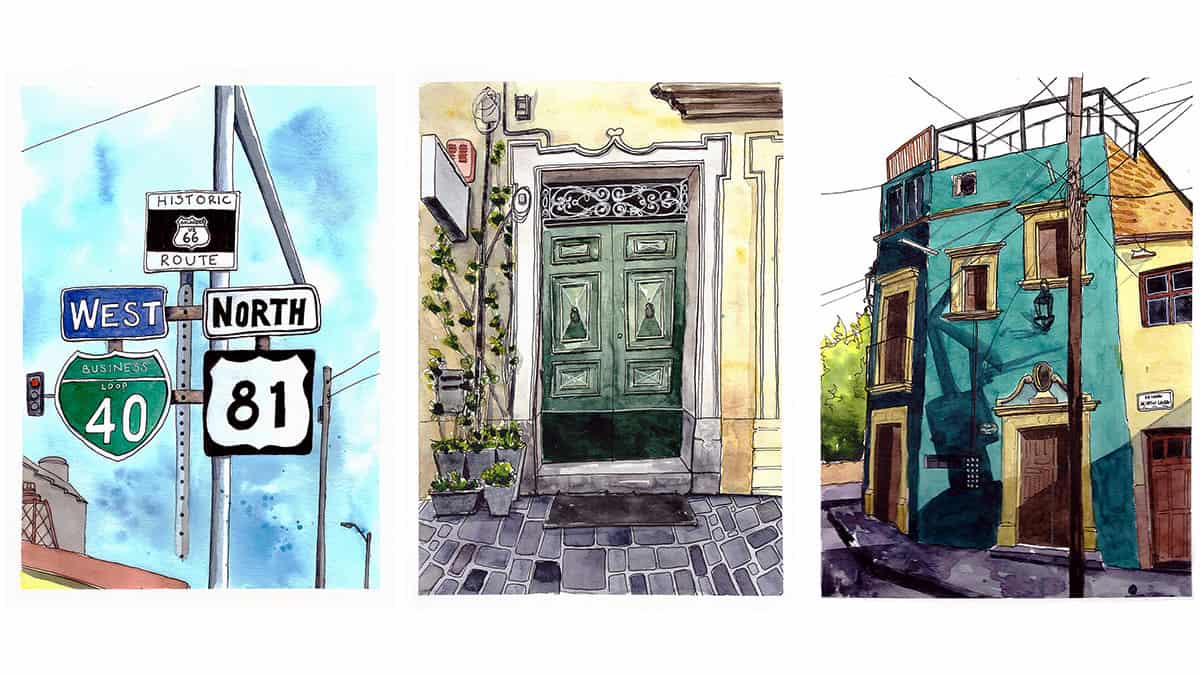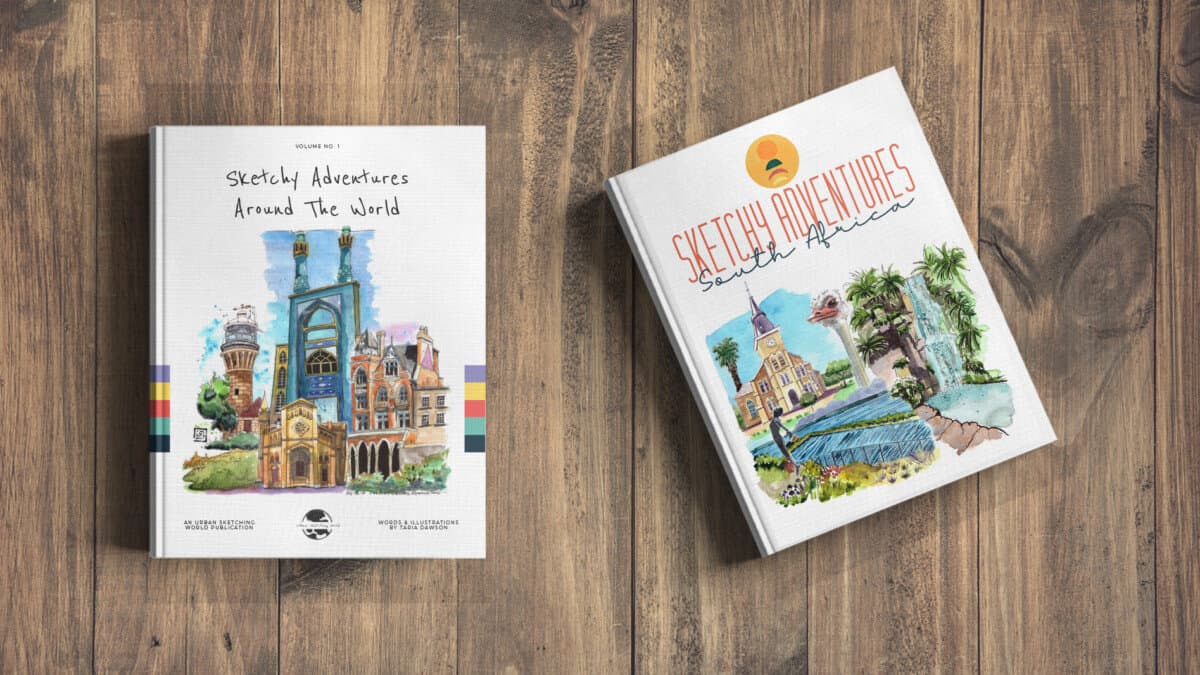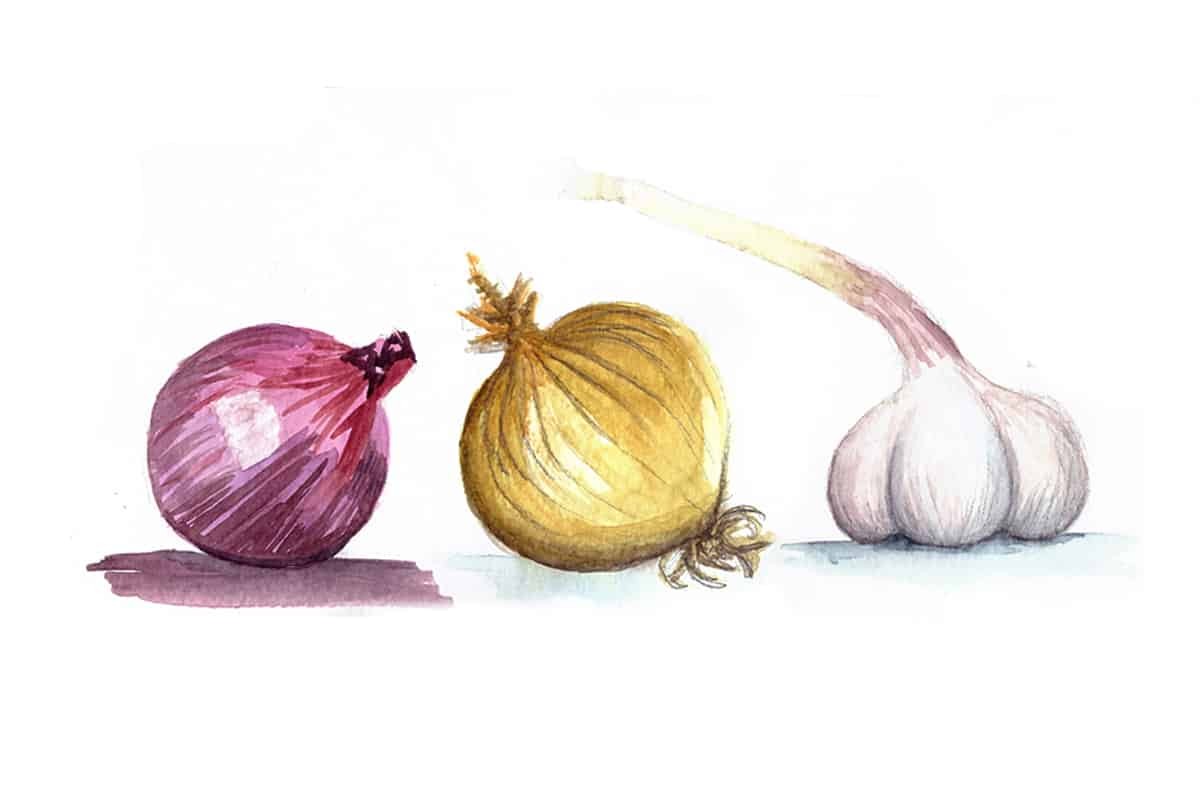One of the captivating things about urban sketching and checking out the work of other artists is the subject matter they decide to commit to paper.
Some sketchers document political marches or make a record of important social movements or issues. Some sketch incredible architecture while some favour more mundane everyday scenes. Still, other sketchers love to capture covert portraits of unsuspecting cafe or public transport dwellers.
What I find interesting is the fact any and every subject matter can be sketched and seeing it through someone else’s artistic interpretation makes it even more fascinating.
I especially love seeing how urban sketchers interpret food (and beverages) and dining experiences in their sketchbooks.
Food sketched on location can be a bit of a challenge especially if it has just been served to you hot in a yummy restaurant and you just want to eat it.
There are two solutions to this challenge: only sketch cold food and/or sketch faster! There’s no better impetus to learn how to sketch quickly than very tasty food getting colder and colder by the second.
What if you could get your sketching skills to the point where you can capture what you want in your sketchbook quickly and with minimal fuss?
This will open a lot of doors for you when you want to draw bigger more complex things. Sketching food can develop your eye so that you are catching the essence of the subject with minimal lines right there and then.
Sketching food can also help to develop your observation skills as the food needs to be recognisable and perhaps appealing too (if it looks appealing to start with)!
Sketching food tells a story in itself: what you make at home; what snacks you buy on the go; when, where and what you eat at a restaurant – food illustrations could become the subject of an entire sketchbook!
Liz Steel started a project of sketching the food she ate each day. She had to stick to a specific diet and by sketching her food, replaced a written log that you may usually keep when undertaking something like this. It helped her to be more conscious of the food she was eating as she had to sketch every item.
The 7 tips for mastering food sketching are at the end of this post – I recommend you whet your appetite by checking out the examples of food sketches below first before getting to the tips!
Examples of Food Sketches
Anyone who has read a few of my posts will know I’m a huge fan of Liz Steel’s work (aren’t we all)? I love the way she can sketch so quickly and loosely yet totally nails her subject matter:
So, how does Liz manage to sketch her dinner but not let it get cold either?
“The number one rule for me when sketching my meals is that I have to eat my food while it is still hot (warm). As a minimum I get the main edges and shapes down then I can start to eat. I often sketch while I eat – brush in my left hand, fork in my right.” (- Liz Steel)
Want to learn travel sketching in ink & watercolour?
Check out my course, Sketch Your Adventures and for a limited time get 50% OFF!!!

Now that’s dedication.
I love the example below from urban sketcher Paul Wang. It’s super colourful with bold lines, strong geometry and is a little more abstract. Paul’s sketch is a great example that your sketch can be playful and realism is not always the goal – don’t forget to play and invoke your artistic license!
I also love Paul’s bold use of colour and his encouragement to distort and exaggerate the things we see:
And finally, Paul’s little notations as to what’s actually in his food is a great way to give a sketchbook spread a journal feel.
Check out my post on how to get started with illustrated journaling if that’s something you would like to know more about.
Similarly to Liz Steel, Suhita Shirodkar has an incredible way of sketching and painting loosely. While not exactly food, the below sketch of condiments such as ketchup and mustard is fantastic and certainly inspires me to go grab my sketchbook and draw:
Before seeing the description, I knew immediately that the sketch below was of tiger prawns, even though it’s loose and a little more on the abstract side it is still recognisable.
I love the sketching style of Santi Salles, it feels naive yet exciting all at the same time. The sketchbook page below feels like an intimate memo to himself of where he was, what he was eating and drinking and he even includes a little colour swatch chart. There’s just something simple and beautiful about it.
Santi captures the same vibe in his sketch below, done in colour pencils at a restaurant in Barcelona.
I really love how Santi has sketched Friday night dinner in the sketch below, not only the food but the table, people and the whole dinner experience itself.
I’m always appreciative of Danny Hawk’s beautiful clean illustration style, he does not tend to draw much food from what I have seen but here is one example of him doing so:
Felix Scheinberger is another of my favourite artists and another that doesn’t draw food too much but I found this sketch he did on his Instagram feed. I think it’s super interesting to see different sketchers styles come through when sketching a plate of food:
Marie Silver does incredible things in her toned sketchbook. Check out some of her sketches below, I literally want to eat them off the page!
Check out my ebooks with hundreds of ink & watercolour travel sketches from all over the world. Get some inspiration for your next trip…

Art Supplies for Sketching Food
The good news: your usual art supplies will work perfectly for sketching food.
Food packaging can be brighter in colour than you may be used to be working with so perhaps you may need to think about that before heading out to sketch. Santi Salles (mentioned above) layers colour pencils over some of his watercolour work.
I would recommend having an opaque white in your arsenal, whether it’s a gel pen, a paint marker or some white gouache, those final white highlights on a shiny piece of food or a glass will really make things pop (especially if you choose to use toned paper, like Marie Silver).
For more information on some of my favourite art supplies you can check out the following posts:
Watercolour sketchbooks for urban sketching
Watercolour sets for urban sketching
Watercolour brushes for urban sketching
My urban sketching kit for 2020
You can also check out my video below where I talk through the urban sketching supplies I’m currently using:
Get started with sketching food
Right, we have discussed why food sketching is awesome, we have checked out other people’s food sketches and we have discussed the art supplies you will need (anything), now it’s time to get to it. Let’s sketch.
Practice & Experimentation
Tip #1
I think a great place to start is setting up a little still life for yourself. You can choose the traditional artist’s apple, peppers or a random assortment of fruit and vegetables in your fridge.
Fruit and vegetables are fun to sketch because they have interesting organic shapes and textures as well as being super colourful.
No fruit or veg? No judgement.
Pick anything from the cupboard or fridge, it really doesn’t matter. In fact, the whole idea is to be able to sketch anything and everything, whatever happens to be in front of you.
This is actually one of the daily prompts within my 7-Day Urban Sketching at Home Challenge – have you tried it yet? It’s a great place to start if you are new to urban sketching and would like to practice at home before heading out into the world. It’s totally free and I will send you an email each day with a little challenge and a video of me completing a sketch for the day too, filled with some little tips and ideas to help you get started.
Tip #2
Try sketching the same still life in a variety of ways. Try a realistic approach and then try a super free expressionistic approach. Invoke your inner child!
Check out the examples of urban sketchers in this article, choose 2 or 3 different artists and try to replicate their style while sketching the still life in front of you. Do you feel more comfortable with one style over another?
Perhaps you have always strived to sketch in a realistic way but a looser more freeform approach seems to give you more of a sense of joy…or vice versa? I think it’s easy to get locked into a certain style and not feel you can escape that box and try something new.
Tip #3
Similarly to tip #2, try to break out of what you usually do and experiment with a different medium. If you usually use watercolours, try gouache, markers or colour pencils.
Some of my favourite online classes
- Watercolor Travel Journal – Alicia Aradilla
- The Art of Sketching: Transform Your Doodles into Art – Mattias Adolfsson
- Illustrated Diary: Fill Your Sketchbook with Experiences – David Morales
- Illustrating Nature: A Creative Exploration – Laura McKendry
Recording Real Life
Tip #4
Once you have explored some different styles and mediums exchange your still life for recording real meals at home that may have a bit of time pressure attached to them. If you have cooked hot food, the time pressure will be wanting to sketch it and eat it before it gets cold!
Tip #5
Now you are comfortable with sketching and recording your food at home, hit the streets with your sketchbook.
You can visit a cafe by yourself at first and order simple food without any time pressure, such as a cake, pastry or sandwich. Once comfortable with this challenge, add some time pressure, order hot food and sketch it. Try out what Liz Steel does, sketch with one hand and eat with the other!
Sketching with other people
Tip #6
It’s time to sketch in front of others. I don’t know about you but I still hesitate to sketch in front of other people such as my family or friends. I don’t mind the general public so much but trying to sketch with friends around seems more intimidating to me! Let alone if you are having dinner with them.
As urban sketchers though, we are compelled to record the world around us and this won’t always be convenient. Besides, I feel like once the ice is broken and it becomes known that you may wish to draw in your sketchbook over dinner with friends, they will get used to it!
If not, exchange your current friends for urban sketcher friends.
I’m joking! Sort of.
I’m always open to a dinner invite FYI!
Tip #7
Try to capture an entire dining experience, like the sketch of Friday night dinner by Santi Salles above. Sketch the table, the things on it and the people around it.
Final Thoughts
I hope you have found this post useful. I have many other posts on how to sketch things such as:
Or if you want a beginner’s guide to urban sketching then check out this post.
If you want to experiment with different art supplies then these posts may whet your appetite:

